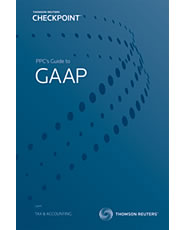Answering commonly asked questions about the generally accepted accounting principles.
Jump to ↓
| What are the GAAP accounting rules? |
| What are the main principles of the GAAP framework? |
| What are the key differences between GAAP and IFRS? |
| What are the GAAP rules for capitalization of costs? |
| What are the main consolidation models under GAAP? |
| GAAP rules for outstanding checks |
| Staying up to date with GAAP standards |
Accurately tracking and presenting financial information can be complex, even for smaller organizations. Therefore, it is critical that organizations use standardized accounting practices when reporting financial information to ensure the information is transparent, consistent, and comparable. Enter Generally Accepted Accounting Principles, more commonly known as GAAP.
GAAP has evolved over the years, but its roots date back to the Stock Market Crash of 1929 and the subsequent Great Depression. It was thought that shady financial reporting practices by some publicly-traded entities caused (or partly caused) the financial calamities. Acting on this suspicion, the federal government worked with the accounting profession to make a change by standardizing financial reporting and establishing best practices.
Such legislation as the Securities Act of 1933 and the Securities Exchange Act of 1934 marked the establishment of the GAAP rules.
Today, GAAP is a required accounting practice for for-profit companies, non-profits, and government entities in the United States. So, what are the GAAP accounting rules? And how can accounting professionals stay up to date with GAAP standards? This article will address these questions and more. Let’s take a closer look.
What are the GAAP accounting rules?
Established by the Financial Accounting Standards Board (FASB) and the Governmental Accounting Standards Board (GASB), GAAP is a set of standardized accounting rules, requirements, and practices to guide how financial statements are prepared and presented.
This is important as it helps to ensure a clear and consistent presentation of financial statements, making it easier for people to understand the information contained in the statements and to compare the financials of one entity with those of another entity. Any entity that publicly releases financial statements must adhere to the GAAP principles and procedures as required by U.S. securities law.
For for-profit entities and non-profits, GAAP aims to provide useful financial information for stakeholders, lenders, or others that have a vested interest or may provide the entity with resources. For state and local governments, an additional objective comes into play: to help taxpayers, and others who use governmental financial statements, hold those government bodies accountable.
What are the main principles of the GAAP framework?
At the core of the GAAP rules are 10 main principles that aim to standardize, define, and regulate the reporting of an organization’s financial information.
The 10 key principles are:
- Principle of Regularity: An entity’s accounting must strictly adhere to the GAAP standards.
- Principle of Consistency: The accounting practices are both consistent and comparable each reporting period.
- Principle of Sincerity: The organization’s accountants are committed to accuracy and objectivity.
- Principle of Permanence of Methods: The accounting practices are consistent throughout the preparation of all financial reports.
- Principle of Non-Compensation: Regardless of whether an organization’s performance is positive or negative, all aspects of the performance are reported with no prospect of debt compensation.
- Principle of Prudence: All of the accounting entries are free of speculation to ensure that entries are realistic and timely.
- Principle of Continuity: It is assumed that the entity will remain in business based on its asset valuations.
- Principle of Periodicity: The accounting periods are routine and consistent (i.e., divided by fiscal quarters or fiscal years).
- Principle of Materiality: All of the data in the financial reports is based on factual information to fully disclose the entity’s monetary position and assets are valued at cost.
- Principle of Utmost Good Faith: All of those involved in the accounting process are being truthful and honest.
What are the key differences between GAAP and IFRS?
The are two main sets of accounting standards that most businesses follow. One is GAAP and the other is IFRS (International Financial Reporting Standards). There are some similarities between GAAP and IFRS; however, there are several key differences that should not be overlooked.
One obvious difference is that most U.S. businesses adhere to GAAP, while entities in countries outside of the United States adhere to IFRS. The IFRS Accounting Standards are developed by the International Accounting Standards Board (IASB).
Pilar Garcia, CPA, Tax and Accounting Executive Editor for Thomson Reuters, further explained some key differences: “The primary difference between the two sets of standards is the underlying methodology. Historically, U.S. GAAP is rules-based, whereas the underlying methodology for IFRS is principles-based. A principles-based standard allows more flexibility in how an accounting standard is interpreted and applied to certain transactions.”
Garcia also outlined several major accounting differences between GAAP and IFRS. These include:
- Inventory accounting: Under U.S. GAAP, an entity can value inventory using the Last In First Out (LIFO) method. Under IFRS, the LIFO method is prohibited.
- Research and development (R&D): Under U.S. GAAP, virtually all costs for R&D are expensed as incurred. Under IFRS, R&D is generally expensed, but some R&D costs can be capitalized and amortized over time if the company can prove commercial viability.
- Lessee accounting: Under U.S. GAAP, a lessee distinguishes between finance and operating leases. Under IFRS, a lessee accounts for all leases as finance leases. This dissimilar treatment results in subsequent measurement differences.
What are the GAAP rules for capitalization of costs?
As a general rule of thumb, GAAP allows for the capitalization of costs if it anticipated that the organization will receive future benefits (usually over a long-term period) from utilizing the asset or expenditure.
However, the rules for capitalization of costs are not always clear and, in these instances, it is especially important to exercise best judgement and diligently document the accounting conclusion.
“In some cases, the GAAP is straight forward, such as the accounting for fixed assets. In other cases, the GAAP is highly technical, such as the accounting for costs related to internal-use software or the accounting for certain transactions in connection with a business combination,” said Garcia. “When this question comes up, it is often because U.S. GAAP is silent on whether a particular cost should be capitalized or expensed, and a company might have to adopt an accounting policy. In these situations, management must exercise judgment and carefully document its accounting conclusion.”
 |
BookPPC’s Guide to GAAP is an up-to-date, comprehensive, and easy-to-use resource for researching and applying GAAP. |
What are the main consolidation models under GAAP?
In U.S. GAAP, there are two primary models for determining if consolidation is required due to a controlling financial interest. These models are the variable interest entity (VIE) model and the voting interest entity model.
A reporting entity must assess whether the VIE model applies to its specific set of facts and circumstances. If the VIE model does not apply, the entity then defaults to the voting interest entity model. A reporting entity cannot simply choose which consolidation model to use.
Variable interest entity model (VIE)
A party with a controlling financial interest in a VIE has both of the following: (a) the power to direct the activities of the VIE that most significantly affect the VIE’s economic performance and (b) an obligation to absorb losses of the VIE or the right to receive benefits from the VIE that could potentially be significant to the VIE.
There are many facets and complexities to the VIE model, and determining the primary beneficiary is one of them. Multiple parties can have a variable interest in a VIE; however, only one party can be identified as the primary beneficiary. It is the primary beneficiary that consolidates the entity. It should be noted that a private company can elect not to apply the VIE guidance, if certain conditions are met.
Voting interest entity model
Under the voting interest entity model, a party generally has a controlling financial interest in an entity if it owns more than 50% of the outstanding voting shares of that entity.
Garcia noted, “The consolidation guidance is complicated and includes specific terminology and complex rules. Over time, the guidance has evolved to prevent accounting abuse, such as structuring a transaction in a way to avoid consolidation so that a parent does not have to report a subsidiary’s liabilities on its balance sheet or to hide losses. It is critical for accountants to understand the terminology and rules to apply the consolidation guidance correctly.”
GAAP rules for outstanding checks
When it comes to outstanding checks, it is important to prioritize the interpretation of the U.S. GAAP rules in FASB ASC 210 concerning the composition of “cash available for current operations” and rules that allow or prohibit the offsetting of certain asset and liability balances.
“Because outstanding checks are still company obligations at the time of reporting, it is common practice to present outstanding checks as liabilities on the financial statement balance sheet. That said, AICPA Q&A Section 1100.08 seemingly conflicts with this practice because it indicates that outstanding checks should be reported as a reduction of cash,” Garcia said.
While certainly helpful, the AICPA’s Q&A document is non-authoritative, said Garcia, who stressed the importance of turning to the U.S. GAAP rules in FASB ASC 210.
Staying up to date with GAAP standards
In today’s ever-changing regulatory environment, it can be challenging to stay up to date on GAAP standards and other accounting developments. However, with the right tools and resources accounting professionals can be confident they have the latest developments at hand.
Turn to a solutions provider that helps ensure your firm is on the right path. For instance, Thomson Reuters Checkpoint Catalyst: US GAAP and GAAP Reporter, both available on Checkpoint, are updated with summaries within days of the FASB issuing an Accounting Standards Update or an Exposure Draft.
With Thomson Reuters, you can know that your firm has quick and easy access to valuable insights on business combinations, consolidation, financial instruments, income taxes, leases, and revenue recognition.
For more information, view the brochure on Checkpoint Catalyst: US GAAP for all areas of coverage, or get started with a free trial to Checkpoint Edge.
Blog |
 |
 |
BlogAICPA Code of Professional Conduct: What accountants need to know. |







